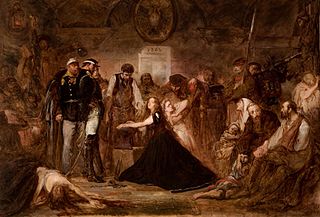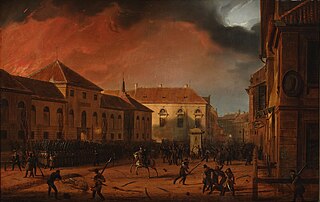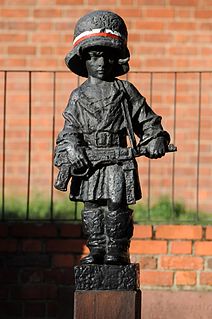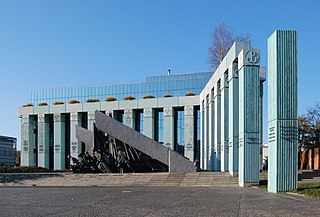See also
| This disambiguation page lists articles associated with the title Warsaw Uprising. If an internal link led you here, you may wish to change the link to point directly to the intended article. |
Warsaw Uprising may refer to:
| This disambiguation page lists articles associated with the title Warsaw Uprising. If an internal link led you here, you may wish to change the link to point directly to the intended article. |

Warsaw is the capital and largest city of Poland. The metropolis stands on the Vistula River in east-central Poland and its population is officially estimated at 1.8 million residents within a greater metropolitan area of 3.1 million residents, which makes Warsaw the 7th most-populous capital city in the European Union. The city limits cover 517.24 square kilometres (199.71 sq mi), while the metropolitan area covers 6,100.43 square kilometres (2,355.39 sq mi). Warsaw is an alpha- global city, a major international tourist destination, and a significant cultural, political and economic hub. Its historical Old Town was designated a UNESCO World Heritage Site.

Warsaw Ghetto was the largest of the Nazi ghettos during World War II. It was established by the German authorities in November 1940; within the new General Government territory of occupied Poland. At its height as many as 460,000 Jews were imprisoned there, in an area of 3.4 km2 (1.3 sq mi), with an average of 9.2 persons per room, barely subsisting on meager food rations. From the Warsaw Ghetto, Jews were deported to Nazi concentration camps and mass-killing centers. In the summer of 1942 at least 254,000 Ghetto residents were sent to the Treblinka extermination camp during Großaktion Warschau under the guise of "resettlement in the East" over the course of the summer. The ghetto was demolished by the Germans in May 1943 after the Warsaw Ghetto Uprisings which had temporarily halted the deportations. The total death toll among the prisoners of the Ghetto is estimated to be at least 300,000 killed by bullet or gas, combined with 92,000 victims of starvation and related diseases, the Warsaw Ghetto Uprising, and the casualties of the final destruction of the Ghetto.

The Warsaw Uprising was a major World War II operation, in the summer of 1944, by the Polish underground resistance, led by the Polish resistance Home Army, to liberate Warsaw from German occupation. The uprising was timed to coincide with the retreat of the German forces from Poland ahead of the Soviet advance. While approaching the eastern suburbs of the city, the Red Army temporarily halted combat operations, enabling the Germans to regroup and defeat the Polish resistance and to destroy the city in retaliation. The Uprising was fought for 63 days with little outside support. It was the single largest military effort taken by any European resistance movement during World War II.

The January Uprising was an insurrection principally in Russia's Kingdom of Poland aimed at the restoration of the Polish–Lithuanian Commonwealth. It began on 22 January 1863 and continued until the last insurgents were captured by the Russian forces in 1864.

The November Uprising (1830–31), also known as the Polish–Russian War 1830–31 or the Cadet Revolution, was an armed rebellion in the heartland of partitioned Poland against the Russian Empire. The uprising began on 29 November 1830 in Warsaw when the young Polish officers from the local Army of the Congress Poland's military academy revolted, led by lieutenant Piotr Wysocki. Large segments of the peoples of Lithuania, Belarus, and the Right-bank Ukraine soon joined the uprising. Although the insurgents achieved local successes, a numerically superior Imperial Russian Army under Ivan Paskevich eventually crushed the uprising. The Russian Emperor Nicholas I decreed that henceforth Russian-occupied Poland would lose its autonomy and become an integral part of the Russian Empire. With Warsaw remaining little more than a military garrison, its university closed.

The ghetto uprisings during World War II were a series of armed revolts against the regime of Nazi Germany between 1941 and 1943 in the newly established Jewish ghettos across Nazi-occupied Europe. Following the German and Soviet invasion of Poland in September 1939, Polish Jews were targeted from the outset. Within months inside occupied Poland, the Germans created hundreds of ghettos in which they forced the Jews to live. The new ghettos were part of the German official policy of removing Jews from public life with the aim of economic exploitation. The combination of excess numbers of inmates, unsanitary conditions and lack of food resulted in a high death rate among them. In most cities the Jewish underground resistance movements developed almost instantly, although ghettoization had severely limited their access to resources.

The Warsaw Ghetto Uprising was the 1943 act of Jewish resistance in the Warsaw Ghetto in German-occupied Poland during World War II to oppose Nazi Germany's final effort to transport the remaining ghetto population to Majdanek and Treblinka death camps.

Żydowski Związek Wojskowy was an underground resistance organization operating during World War II in the area of the Warsaw Ghetto, which fought during the Warsaw Ghetto Uprising and 1944 Warsaw Uprising. It was formed, primarily of former officers of the Polish Army, in late 1939, soon after the start of the German occupation of Poland.
The Białystok Ghetto uprising was an insurrection in the Jewish Białystok Ghetto against the Nazi German occupation authorities during World War II. The uprising was launched on the night of August 16, 1943 and was the second-largest ghetto uprising organized in Nazi-occupied Poland after the Warsaw Ghetto Uprising of April–May 1943. It was led by the Anti-Fascist Military Organisation, a branch of the Warsaw Anti-Fascist Bloc.

Yitzhak Zuckerman, also known by his nom de guerre "Antek", was one of the leaders of the Warsaw Ghetto Uprising in 1943 against Nazi Germany during World War II.

Wola is a district in western Warsaw, Poland, formerly the village of Wielka Wola, incorporated into Warsaw in 1916. An industrial area with traditions reaching back to the early 19th century, it underwent a transformation into an office (commercial) and residential district. Several museums are located in Wola, notably the Warsaw Uprising Museum.

Marek Edelman was a Polish political and social activist and cardiologist. Edelman was the last surviving leader of the Warsaw Ghetto Uprising and, long before his death, was the last one to stay in Poland despite harassment by the Communist authorities.

The Warsaw Uprising Museum, in the Wola district of Warsaw, Poland, is dedicated to the Warsaw Uprising of 1944. The institution of the museum was established in 1983, but no construction work took place for many years. It opened on July 31, 2004, marking the 60th anniversary of the uprising.

The Wola massacre was the systematic killing of between 70,000 and 90,000 Poles in the Wola suburb of Poland's capital city, Warsaw, by German Wehrmacht and fellow Axis collaborators in the Aserbaidschanische Legion, as well as the mostly-Russian RONA forces. The massacre was ordered by Hitler, who directed to kill "anything that moves" to stop the Warsaw Uprising soon after it began.

The Cross of the Warsaw Uprising was an informal award used by soldiers of the Polish resistance during the Warsaw Uprising of 1944. It consisted of a (captured) German Iron Cross, with a pre-war 1 złoty coin pinned to it in the centre over the swastika. The reverse side of the coin, showing the Polish eagle, was displayed, to which was added a kotwica and the inscription "1944", it was awarded for killing an SS officer in combat.

Mały Powstaniec is a statue in commemoration of the child soldiers who fought and died during the Warsaw Uprising of 1944. It is located on Podwale Street, next to the ramparts of Warsaw's Old Town.

The destruction of Warsaw was Nazi Germany's substantially-effected razing of the city in late 1944, after the 1944 Warsaw Uprising of the Polish resistance. The uprising infuriated German leaders, who decided to destroy the city as retribution.

The Grossaktion Warsaw was the Nazi code name for the deportation and mass murder of Jews from the Warsaw Ghetto beginning 22 July 1942. During the Grossaktion, Jews were terrorized in daily round-ups, marched through the ghetto, and assembled at the Umschlagplatz station square for what was called in the Nazi euphemistic jargon "resettlement to the East". From there, they were sent aboard overcrowded Holocaust trains to the extermination camp in Treblinka.

Ludwig Fischer was a German Nazi Party lawyer, politician and a convicted war criminal who was executed for war crimes.

Warsaw Uprising Monument is a monument in Warsaw, Poland, dedicated to the Warsaw Uprising of 1944. Unveiled in 1989, it was sculpted by Wincenty Kućma and the architect was Jacek Budyn. It is located on the southern side of Krasiński Square.